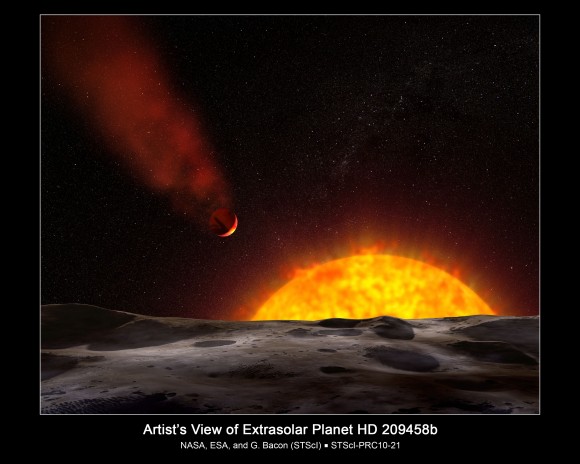The planet HD 209458b is losing its atmosphere to space, and to an onlooker it might look like a Jupiter-sized comet. But don't worry, it has enough atmosphere to lose even for a billion years

Observations made with the Hubble Space Telescope's Origins Spectrograph (COS) confirmed suspicions in 2003 that the planet HD 209458b behaves like a Jupiter-sized comet, losing its atmosphere in a giant plume due to the strong solar wind of its very close star.
HD 209458b is a "hot Jupiter" type planet: a gas giant orbiting its star very close. The duration of the revolution - the planet's year is 3.5 Earth days, which makes it faster than Mercury, which orbits our Sun once every 88 days.
Astronomers have been able to learn a lot of details about HD 209458b because it is a transiting planet HD 209458 as seen from Earth. This means that it blocks some of the starlight as it passes by. Therefore, it is possible to learn about the size of the planet and locate more or less within a certain range its mass. Indeed, the mass of HD 209458b is no more than two-thirds the mass of Jupiter, but the heat coming from the star inflated it to a diameter two and a half times that of Jupiter.
In the case of HD 209458b, the passage of the star's light through the escaping atmosphere, which has a wall reaching 1,100 degrees Celsius, allowed scientists to know what it is made of and how quickly it is lost to space.
"We found that the gas escaped at high speeds, and a very large amount of gas was moving towards us at a speed of 35 km/h," said astronomer Jeffrey Linsky from the University of Colorado in Boulder, the COS research leader. "The large gas flow originates from gas blown away by the stellar wind and forming a comet-like tail trailing behind the planet."
The escaping gas absorbs the star's light at wavelengths characteristic of heavy elements such as carbon and sulfur, indicating that the star's immense heat drives circulation in the depths of HD 209458b's atmosphere, raising materials that would otherwise remain below the few light materials such as hydrogen. Although its atmosphere is lost to space, HD 209458b is in no danger of disappearing anytime soon. According to atmospheric loss rate measurements the planet will still exist for about a billion years, a greater amount of time than its sun has left.
Translation: Avi Blizovsky

6 תגובות
Why is it a danger if the star disappears or ends, what does it give us if it remains for another billion years?
Interesting, heartwarming sight for sure.
4 room apartment for sale beautiful view across one of the moons of HD209458b
First come first served
Until there is affordable housing in Israel (10000 years)
What ten thousand years? How long do I have to wait?
Oh ..
Another planet that has no chance to settle! What a drag!
Why invest so much effort outside our solar system when it is clear
That the earth needs a closer and better solution in the next 10,000 years!!!
It is better that all resources be directed to Mars, the Moon and Titan!!!